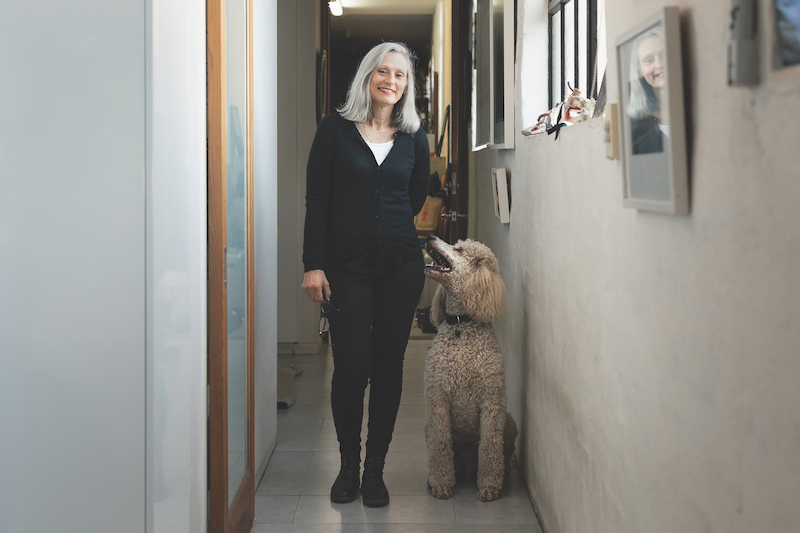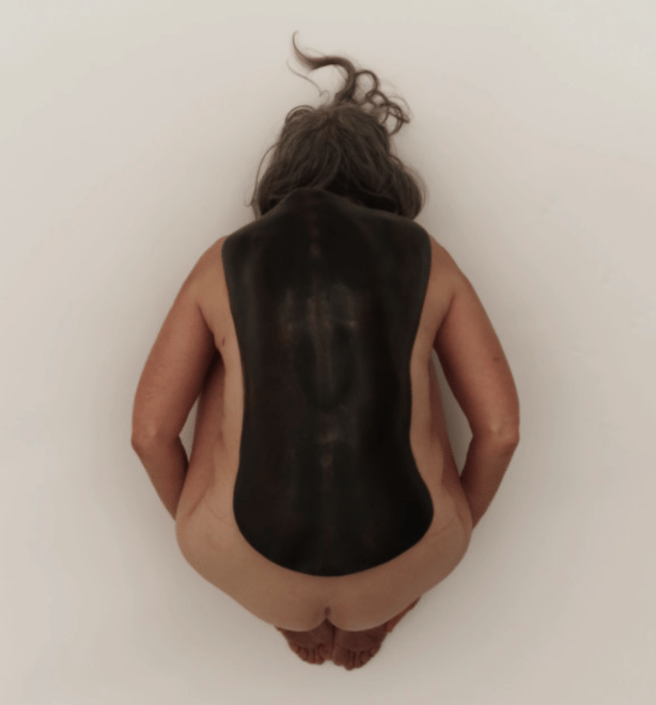Julie Rrap: The Fast and The Funny
After four decades of practice, Julie Rrap is still doing what she does best: raising serious issues with dry humour, sharp wit and shrewd irony.
Words: Tracey Clement
Photography: Jacquie Manning
JULIE RRAP HAS A WICKED sense of humour. She’s telling a story about spending time in Belgium with the artist Wim Delvoye. “He was really mischievous,” she says, “and we used to play this game: ‘When should the artist have died?’” And then she laughs, a big burst of genuine merriment that is infectious. When we both recover, she continues, “It was really fun. You know, you think an artist was going really well, but then their work starts to get a bit crap… At some point maybe they should have stopped.” Rrap is still smiling, but there is a serious edge to this conversation. Underneath this amusing anecdote lies the harsh realities of the art world and the spectre of mortality – an always present fact of life that looms larger in the imagination the older we get. As Rrap cheerfully points out: “You have to be practical. I’ll be 70 next year…”
But, as she prepares for a solo show of new work, Twisted Logic, at ARC ONE Gallery in Melbourne, it’s clear that Rrap isn’t yet decelerating, let alone grinding to a halt. She’s still doing what she has always done, what her work is known for: raising serious issues with dry humour, sharp wit and irony.
Rrap’s practice encompasses photography, video, sculpture and installation. But she says, “if push came to shove, my favourite is probably making sculpture”. Not, she is quick to admit, “that I was trained in it”. Rrap’s first solo show was Disclosures, a 1982 photographic installation of self-portraits, staged long before either installations or selfies were the done thing. This critically acclaimed debut was collected by the Museum of Contemporary Art a decade later.
In fact, Rrap doesn’t have a photography degree either. In 1971 she completed a Bachelor of Arts from the University of Queensland, majoring in English, Classics and Fine Arts. In the mid-1970s she studied drawing and painting at what is now the National Art School in Sydney and was an external student at the University of Sydney’s Tin Sheds workshop. But, she says, “I probably started off through performance. Not that I did performance, but I was hanging out with Mike. And that’s the world I got introduced to as an artist.” Mike, of course, is her older brother, the seminal performance artist Mike Parr. And an element of performativity – along with a critical sense of humour and a strong belief in the feminist tenet that the personal is political – continues to run through her disparate bodies of work.
All three of these elements coalesce in Rrap’s now iconic image Overstepping (2001). In this digitally manipulated photo, which won the Hermann’s Art Award, the artist morphed her own bare feet into fleshy high heels, complete with skin creases and tender looking red tips.
At the time art critic George Alexander wrote in Artlink magazine: “it looks like a miracle and feels like a mistake”. Rrap herself says “some people think of them as grotesque, but I think they’re quite amusing”. And indeed they are, but Rrap’s impossible feet also point to the cruelty of normative feminine beauty standards and the painful regimes women subject themselves to in an attempt to measure up.
While most of Rrap’s work is deeply, if subtly, political, she never sets out to be didactic. She doesn’t start with a pressing issue. “I can’t work that way,” she says emphatically. “I can’t bear making art like that.” Instead Rrap finds what she is trying to say through the process of creation itself. “Art is a thinking process,” she says. “And it comes out of making.” As she explains, you just can’t force an idea. If you do, “the work turns around and says ‘Look stupid, this is the way it has to be, and this is the right way’. And I often have those moments. And I wait for them.”
Yet, as an artist Rrap does have something to say. “My political life started at university, marching in the streets in the 1960s. So I’ve always had an interest in how art connects with the world.” And using humour to raise political issues is one of her key strategies. “I think we can facilitate meaningful exchanges through the mechanism of humour,” she says. “It doesn’t have to be laugh-out-loud funny, but some sort of irony, something playful. People are more open to that. It’s a more open space to have a discussion than lecturing or hectoring.”
Rrap’s process of starting with a visual image and ending in a political statement can be seen in her recent bronze sculpture, Speechless. This sculptural response to Max Dupain’s famous 1937 photograph, Sunbaker, was made for the 2017 group show Under the Sun. Rrap began by wondering what the prone figure would look like from underneath and ended up casting the negative space of his head and arms in a bronze lectern. Visitors to the show were invited to assume the position, if they wanted. “You could walk up to the lectern, and get this moment where you could speak out, and what do you do? You put your head down. So it’s a kind of playful take on that image of Australia as a light-hearted leisure land, but really, we don’t take on issues enough,” she explains.
In her upcoming solo Twisted Logic, Rrap hopes to bring a similarly light touch to “that quite slippery relationship between art, culture, and any particular political regime or system that happens to be in power”. She has been thinking about the fact that bronze sculptures used to be melted down to make armaments. Her show will feature ambiguous bronze elements, cast from her body, that could be read as either weapons or armour.
When we meet in her studio, she is still in the process of deciding how to “animate” these works through accompanying videos, photo- graphs or performances. Yet she admits: “I’m working on this show now and it has already made me think about another version.” Julie Rrap isn’t even close to slowing down.
VICTORIA LYNN
Director, TarraWarra Museum of Art, Healesville
Victoria Lynn curated the major 2007–08 survey of Julie Rrap’s work at the Museum of Contemporary Art, Body Double. She also wrote the accompanying monograph and continues to follow Rrap’s practice with interest. For Lynn, Rrap is an important artist, not because she comments on the world we live in, but because she helps create it. “Art is a world-making activity,” she says. “Julie shows us the capacity of the human imagination to conceive of images that take her work, and our perception of it, to new depths and new possibilities.”
Lynn, who is now the Director of the TarraWarra Museum of Art, adds: “Julie is a major Australian artist who has a unique vision. Her video, photographic, installation and sculptural works explore the idea of the trickster, the body double, and a fragmented body. Her work has been highly influential and is always surprising at every turn.”
Although Lynn has observed Rrap’s work change over time, she notes that both humour and conceptual rigour are constants in an ever-evolving practice. “Julie has a wonderful and mischievous sense of humour combined with an astute and intelligent mind. She is always pushing her practice to new horizons and is never scared of experimenting with new media and new ideas.”
FRAN CLARK
Co-director, ARC ONE Gallery, Melbourne
When asked what kind of individual should invest in work by Julie Rrap, her Melbourne dealer Fran Clark, co-director of ARC ONE Gallery, doesn’t hesitate. “A collector wanting to acquire important challenging artworks that reflect intelligent ideas,” she says. “Someone who is aware of the importance of history in the canon of art and the relevance a significant artist plays within that history. Deep thinkers with a good sense of humour and love for how artforms shape concepts and can playfully shift the automatic way we process those ideas.”
Clark, who has worked with the artist since 1999, first with Robert Lindsay Gallery and then with ARC ONE from 2002, says that “Rrap produces timeless works. Even a quick glance at her resume reveals a practice that is formidable.” She recalls seeing Rrap’s work for the first time: “I was immediately struck by this artist’s unique creativity; an artist of intelligence producing strong and iconic art with an excellent grip on that ever-elusive quality, humour.”
Collectors interested in acquiring work by this established artist should try to catch her shows in commercial galleries, or request to see work from the stockroom. According to Clark, “It is rare to see Julie’s work come up in the secondary market”. Those who make the effort won’t be disappointed. As Clark points out: “Prices for her work never decrease.”
This article was originally published in Art Collector issue 89, JUL – SEP 2019.









